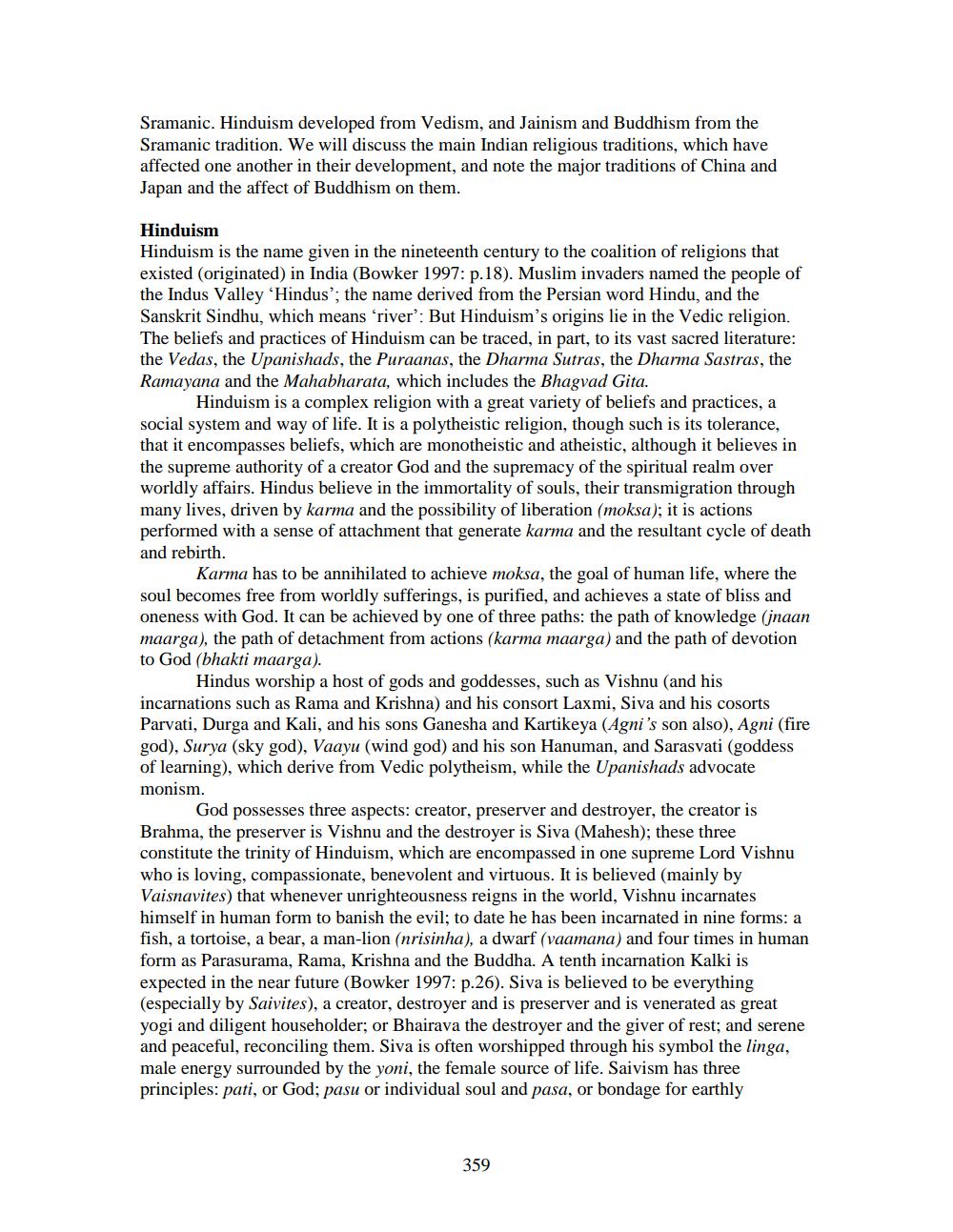________________
Sramanic. Hinduism developed from Vedism, and Jainism and Buddhism from the Sramanic tradition. We will discuss the main Indian religious traditions, which have affected one another in their development, and note the major traditions of China and Japan and the affect of Buddhism on them.
Hinduism Hinduism is the name given in the nineteenth century to the coalition of religions that existed (originated) in India (Bowker 1997: p.18). Muslim invaders named the people of the Indus Valley 'Hindus'; the name derived from the Persian word Hindu, and the Sanskrit Sindhu, which means 'river': But Hinduism's origins lie in the Vedic religion. The beliefs and practices of Hinduism can be traced, in part, to its vast sacred literature: the Vedas, the Upanishads, the Puraanas, the Dharma Sutras, the Dharma Sastras, the Ramayana and the Mahabharata, which includes the Bhagvad Gita.
Hinduism is a complex religion with a great variety of beliefs and practices, a social system and way of life. It is a polytheistic religion, though such is its tolerance, that it encompasses beliefs, which are monotheistic and atheistic, although it believes in the supreme authority of a creator God and the supremacy of the spiritual realm over worldly affairs. Hindus believe in the immortality of souls, their transmigration through many lives, driven by karma and the possibility of liberation (moksa); it is actions performed with a sense of attachment that generate karma and the resultant cycle of death and rebirth.
Karma has to be annihilated to achieve moksa, the goal of human life, where the soul becomes free from worldly sufferings, is purified, and achieves a state of bliss and oneness with God. It can be achieved by one of three paths: the path of knowledge (jnaan maarga), the path of detachment from actions (karma maarga) and the path of devotion to God (bhakti maarga).
Hindus worship a host of gods and goddesses, such as Vishnu (and his incarnations such as Rama and Krishna) and his consort Laxmi, Siva and his cosorts Parvati, Durga and Kali, and his sons Ganesha and Kartikeya (Agni's son also), Agni (fire god), Surya (sky god), Vaayu (wind god) and his son Hanuman, and Sarasvati (goddess of learning), which derive from Vedic polytheism, while the Upanishads advocate monism.
God possesses three aspects: creator, preserver and destroyer, the creator is Brahma, the preserver is Vishnu and the destroyer is Siva (Mahesh); these three constitute the trinity of Hinduism, which are encompassed in one supreme Lord Vishnu who is loving, compassionate, benevolent and virtuous. It is believed (mainly by Vaisnavites) that whenever unrighteousness reigns in the world, Vishnu incarnates himself in human form to banish the evil; to date he has been incarnated in nine forms: a fish, a tortoise, a bear, a man-lion (nrisinha), a dwarf (vaamana) and four times in human form as Parasurama, Rama, Krishna and the Buddha. A tenth incarnation Kalki is expected in the near future (Bowker 1997: p.26). Siva is believed to be everything (especially by Saivites), a creator, destroyer and is preserver and is venerated as great yogi and diligent householder, or Bhairava the destroyer and the giver of rest; and serene and peaceful, reconciling them. Siva is often worshipped through his symbol the linga, male energy surrounded by the yoni, the female source of life. Saivism has three principles: pati, or God; pasu or individual soul and pasa, or bondage for earthly
359




